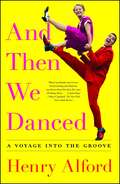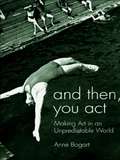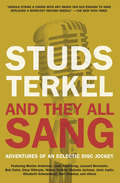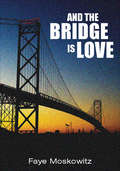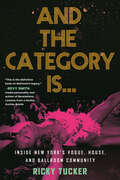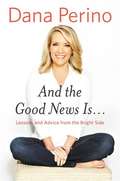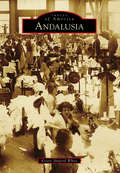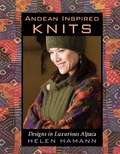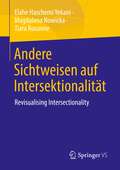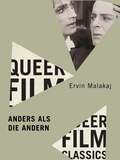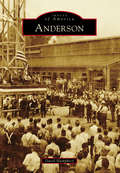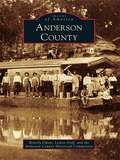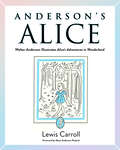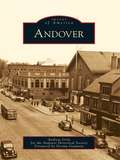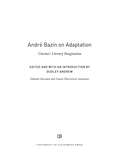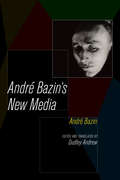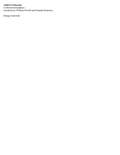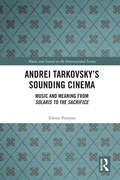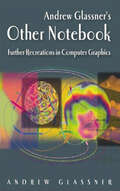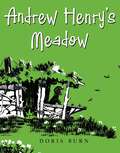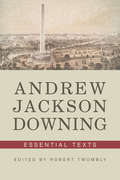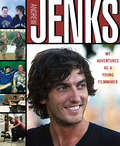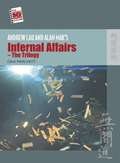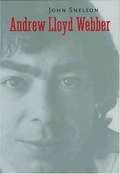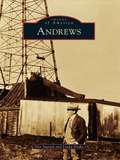- Table View
- List View
And Then We Danced: A Voyage into the Groove
by Henry AlfordEqual parts memoir and cultural history, from acclaimed comic stylist and professional hobbyist Henry Alford comes a hilarious journey through the world of dance that will inform, entertain and leave readers tapping their toes. <P><P>When Henry Alford wrote about his experience with a Zumba class for The New York Times, little did he realize that it was the start of something much bigger. Dance would grow and take on many roles for Henry: exercise, confidence builder, an excuse to travel, a source of ongoing wonder and—when he dances with Alzheimer's patients—even a kind of community service. Tackling a wide range of forms (including ballet, hip-hop, jazz, ballroom, tap, contact improvisation, Zumba, swing), this grand tour takes us through the works and careers of luminaries ranging from Bob Fosse to George Balanchine, Twyla Tharp to Arthur Murray. Rich in insight and humor, Alford mines both personal experience and fascinating cultural history to offer a witty and ultimately moving portrait of how dance can express all things human.
And Then, You Act: Making Art in an Unpredictable World
by Anne BogartFrom well-known auteur of the American theatre scene, Anne Bogart, And Then, You Act is a fascinating and accessible book about directing theatre, acting and the collaborative creative process. Writing clearly and passionately, Bogart speaks to a wide audience, from undergraduates to practitioners, and makes an invaluable contribution to the field tackling themes such as: intentionality inspiration why theatre matters. Following on from her successful book A Director Prepares, which has become a key text for teaching directing classes, And Then, You Act is an essential practitioner and student resource.
And They All Sang: Adventures of an Eclectic Disc Jockey
by Studs TerkelThe Pulitzer Prize–winning historian talks with some of twentieth century&’s most iconic musicians—&“Riveting . . . Just about every interview has a revelation&” (San Francisco Chronicle). Through the second half of the twentieth century, Studs Terkel hosted the legendary radio show &“The Wax Museum,&” presenting Chicago&’s music fans with his inimitable take on music of all kinds, from classical, opera, and jazz to gospel, blues, folk, and rock. Featuring more than forty of Terkel&’s conversations with some of the greatest musicians of the past century, And They All Sang is &“a tribute to music&’s universality and power&” (Philadelphia Inquirer). Included here are fascinating conversations with Louis Armstrong, Leonard Bernstein, Big Bill Broonzy, Bob Dylan, Dizzy Gillespie, Mahalia Jackson, Janis Joplin, Rosa Raisa, Pete Seeger, and many others. As the esteemed music critic Anthony DeCurtis wrote in the Chicago Tribune, &“the terms &‘interview&’ or &‘oral history&’ don&’t begin to do justice to what Terkel achieves in these conversations, which are at once wildly ambitious and as casual as can be.&” Whether discussing Enrico Caruso&’s nervousness on stage with opera diva Edith Mason or the Beatles&’ 1966 encounter in London with revered Indian sitar player Ravi Shankar, &“Terkel&’s singular gift for bringing his subjects to life in their own words should strike a chord with any music fan old enough to have replaced a worn-out record needle&” (The New York Times). &“Whether diva or dustbowl balladeer, Studs treats them all alike, with deep knowledge and an intimate, conversational approach . . . as this often remarkable book shows, Studs Terkel has remained mesmerized by great music throughout his life.&” —The Guardian &“[Terkel&’s] expertise is evident on every page, whether debating the harmonic structure of the spirituals or discerning the subtleties of Keith Jarrett&’s piano technique . . . As ever, he is the most skillful of interviewers.&” —The Independent &“What makes And They All Sang a rousing success isn&’t just Terkel&’s phenomenal range and broad knowledge, it&’s his passionate love of the music and his deep humanity.&” —San Francisco Chronicle
And the Bridge Is Love: Life Stories (Jewish Women Writers Ser.)
by Faye Moskowitz"A book that will make you stand up and cheer."--The Detroit News "Bridges the gap between humor and despair, past and present, Jew and gentile, to reveal its author's simple humanity, deeply rooted in her unwavering love of family. . . . Touching and compelling."--The Washington Post "A modern woman's ancient voice, full of the juicy taste of life--knowing, loving, feeling, and clever."--Lore Segal The Feminist Press brings back into print a literary gem. Faye Moskowitz is author of A Leak in the Heart: Personal Essays and Life Stories and Whoever Finds This: I Love You, a collection of stories. She teaches writing at George Washington University.
And the Category Is…: Inside New York’s Vogue, House, and Ballroom Community
by Ricky TuckerAn Electric Literature &“Most Anticipated LGBTQ+ Book of 2022&” Selection A love letter to the legendary Black and Latinx LGBTQ underground subculture, uncovering its abundant legacy and influence in popular culture.What is Ballroom? Not a song, a documentary, a catchphrase, a TV show, or an individual pop star. It is an underground subculture founded over a century ago by LGBTQ African American and Latino men and women of Harlem. Arts-based and intersectional, it transcends identity, acting as a fearless response to the systemic marginalization of minority populations. Ricky Tucker pulls from his years as a close friend of the community to reveal the complex cultural makeup and ongoing relevance of house and Ballroom, a space where trans lives are respected and applauded, and queer youth are able to find family and acceptance. With each chapter framed as a &“category&” (Vogue, Realness, Body, et al.), And the Category Is . . . offers an impressionistic point of entry into this subculture, its deeply integrated history, and how it&’s been appropriated for mainstream audiences. Each category features an exclusive interview with fierce LGBTQ/POC Ballroom members—Lee Soulja, Benjamin Ninja, Twiggy Pucci Garçon, and more—whose life, work, and activism drive home that very category. At the height of public intrigue and awareness about Ballroom, thanks to TV shows like FX&’s Pose, Tucker&’s compelling narratives help us understand its relevance in pop culture, dance, public policy with regard to queer communities, and so much more. Welcome to the norm-defying realness of Ballroom.
And the Good News Is... Lessons and Advice from the Bright Side
by Dana Perino#1 New York Times Bestseller<P> #1 Wall Street Journal Bestseller<P> From her years as the presidential press secretary to her debates with colleagues on Fox News' The Five, Dana Perino reveals the lessons she's learned that have guided her through life, kept her level-headed, and led to her success, even in the face of adversity. <P> Thoughtful, inspiring, and often surprising, AND THE GOOD NEWS IS . . . traces Dana Perino's unlikely journey through politics and television. It's a remarkable American story-made up of equal parts determination and clear-eyed optimism. <P> From facing professional challenges and confronting personal fears to stepping up to a podium for a President, Dana has come to expect the unexpected and has an uncanny ability to find the good news in any tough situation. AND THE GOOD NEWS IS . . . takes us from her Western childhood in Wyoming and Colorado to a chance meeting on an airplane that changes her life entirely. Then, with refreshing honesty and humor, she recounts her frustration with a string of unsatisfying jobs and living circumstances until a key career tip leads her back to Washington, D.C. to work for the Bush Administration.<P> Dana also shares here her best work and life lessons-tips that will help you to get your point across convincingly while allowing your own grace and personality to shine through. As someone who still believes in working together to solve the problems our nation faces, Dana offers clear, practical advice on how to restore civility to our personal and public conversations. The result is a fascinating read that can help anyone become more successful, productive, and joyously content.
Andalusia (Images of America)
by Kristy Shuford WhiteAndalusia's destiny was determined by the Conecuh River, when the 1841 "Harrison Freshet" brought floods and mosquito fever to the original county seat of Montezuma, forcing the move to higher ground. The new site was named Andalusia, and the post office officially relocated in 1844. Like many small towns, Andalusia's destiny could have once again been determined by an outside force--the economy. However, from timber to textiles, Andalusia has chosen to fight back against abandonment and vacancy and can now truly boast a unique and viable commercial downtown that continues to flourish while preserving its historic structures. Andalusia was awarded the 2013 Quality of Life Award by The Alabama Municipal Journal for purchasing the old Alabama Textile Mill (Alatex) in 2009 and for partnering with the chamber of commerce to create a new chamber office, welcome center, and national textile monument in tribute to the thousands who worked at the site and in textile mills all over the United States.
Andean Inspired Knits
by Helen HamannCreate dazzling knitwear designs with Andean Inspired Knits, a collection of patterns inspired by pre-Columbian textiles.
Andere Sichtweisen auf Intersektionalität: Revisualising Intersectionality
by Magdalena Nowicka Elahe Haschemi Yekani Tiara RoxanneDas Buch hinterfragt die vermeintliche visuelle Evidenz von Kategorien menschlicher Ähnlichkeit und Differenz. Es bezieht Erkenntnisse aus den Sozial- und Kognitionswissenschaften sowie der Psychologie und Philosophie ein, um zu erklären, wie wir physische Unterschiede visuell wahrnehmen und zeigt, dass Wahrnehmung sowohl fehlbar als auch prozesshaft ist. Dazu bringen die Autorinnen Studien zur visuellen Kultur und künstlerische Forschung mit Ansätzen wie Gender, Queer und Trans Studies sowie postkolonialer Theorie miteinander ins Gespräch, um vereinfachte Vorstellungen von Identitätspolitik und kultureller Repräsentation zu verkomplizieren. Das Buch schlägt andere Sichtweisen auf Intersektionalität vor, um die Vorherrschaft von Kategorien der vermeintlich sichtbaren Differenz wie race und Geschlecht als analytische Kategorien infrage zu stellen.
Anders als die Andern (Queer Film Classics #7)
by Ervin MalakajReleased in 1919, Anders als die Andern (Different from the Others) stunned audiences with its straightforward depiction of queer love. Supporters celebrated the film’s moving storyline, while conservative detractors succeeded in prohibiting public screenings. Banned and partially destroyed after the rise of Nazism, the film was lost until the 1970s and only about one-third of its original footage is preserved today.Directed by Richard Oswald and co-written by Oswald and the renowned sexologist Magnus Hirschfeld, Anders als die Andern is a remarkable artifact of cinema culture connected to the vibrant pre-Stonewall homosexual rights movement of early-twentieth-century Germany. The film makes a strong case for the normalization of homosexuality and for its decriminalization, but the central melodrama still finds its characters undone by their public outing. Ervin Malakaj sees the film’s portrayal of the pain of living life queerly as generating a complex emotional identification in modern spectators, even those living in apparently friendlier circumstances. There is a strange comfort in knowing that we are not alone in our struggles, and Malakaj recuperates Anders als die Andern’s mournful cinema as an essential element of its endurance, treating the film’s melancholia both as a valuable feeling in and of itself and as a springboard to engage in an intergenerational queer struggle.Over a century after the film’s release, Anders als die Andern serves as a stark reminder of how hostile the world can be to queer people, but also as an object lesson in how to find sustenance and social connection in tragic narratives.
Anderson (Images of America)
by David HumphreyThe city of Anderson is named after Chief William Anderson, whose Indian name was Kikthawenund, meaning "making a noise" or "causing to crack." Early settlers referred to the area as Anderson Town, while the Moravian missionaries called it "The Heathen Town Four Miles Away." It later became Anderstown before the Indiana State Legislature shortened the name to Anderson in 1844. In the spring of 1887, natural gas was discovered in the city. Several industries came to the area, leading to a population explosion. Anderson soon became a "factory town," with General Motors building plants throughout the city. The success of the automobile factories attracted entrepreneurs and made Anderson the economic center of Madison County. From the 1940s through the 1970s, downtown Anderson had its share of family-owned businesses as well as national chain stores like J.C. Penney, Sears & Roebuck, and Montgomery Ward. Today, it remains filled with a rich heritage and continues to grow in a new economic market.
Anderson County
by Anderson County Historical Commission Beverly OdomFrom its roots in the unbroken wilderness of central East Texas, Anderson County has overcome many adversities to become the crossroads of East Texas. In the 1830s, rugged pioneers came to the fertile Trinity River Valley to carve out a place for themselves from the untamed country. These pioneers began a settlement along a stream about 10 miles east of the Trinity River in what would become Anderson County. Other families joined their effort, and Fort Houston was soon built in 1835-1836 to protect settlers from the dangers inherent to the wild frontier. Lost in the passage of time, many communities no longer exist. Today the principal towns are Palestine, Frankston, and Elkhart, but many other communities contribute to the quality of life across the county.
Anderson's Alice: Walter Anderson Illustrates Alice's Adventures in Wonderland
by Lewis CarrollAmong Walter Anderson's best-loved books, An Alphabet and Robinson: The Pleasant History of an Unusual Cat are much admired by children and parents, and have long been given as special gifts emblazoned with Anderson's unique art. In that vein and long in demand is this revived edition of Anderson’s Alice, which carries the renowned artist's visual translation of Lewis Carroll's classic story, Alice’s Adventures in Wonderland. Anderson's Alice, though, is no Victorian doll as she is in the famous illustrations by Sir John Tenniel, Arthur Rackham, and elsewhere. Instead, Anderson represents Alice as an adventurer, capturing her spirit and her energy in bold lines. In Anderson's Alice: Walter Anderson Illustrates “Alice’s Adventures in Wonderland,” ninety-two pen-and-ink drawings accompany the complete text of Lewis Carroll's original narrative. Anderson (1903–1965) drew them alone late at night as he recovered from an illness, and he considered them to be translations of words into visual images rather than illustrations. The story of Alice brought him comfort and inspiration, and he placed her wonderland close to his own homeland by localizing Alice's environment with backgrounds featuring the kinds of wildflowers and crabs that are native to the Gulf Coast. Walter Anderson, often intensely private within his community of Ocean Springs, Mississippi, observed and wrote about nature and produced thousands of drawings and watercolors of the plant and animal life on the Mississippi Coast. These show his strangely beautiful style and a rich and unchecked imagination. With these artistic gifts, Anderson infuses new life into Lewis Carroll's well-loved characters, who have delighted generations of children and adults.
Andover
by Andrew Grilz Norma Gammon Andover Historical SocietyAndover, geographically one of the largest townships in the Commonwealth of Massachusetts, has a long and illustrious history. Founded more than 350 years ago, Andover has played a part in several critical events in American history, including the French and Indian wars, the witchcraft hysteria of the 1690s, the American Revolution, the abolitionist movement, the Civil War, and the Industrial Revolution. It is the birthplace of the song "America," written by Samuel Francis Smith. It has been the home of such notables as Anne Bradstreet, the first poet in the New World; Salem Poor, former slave and hero of the Battle of Bunker Hill; Samuel Osgood, the first postmaster general of the United States; and Harriet Beecher Stowe, author of Uncle Tom's Cabin. It is home to the Andover Village Improvement Society, the second-oldest land conservation group in America. Pres. Franklin Pierce called Andover his summer home, and countless leaders of business and government resided in Andover while students at Phillips Andover Academy, one of the most prestigious private academies in the country.
Andre Bazin on Adaptation: Cinema's Literary Imagination
by André BazinAdaptation was central to André Bazin’s lifelong query: What is cinema? Placing films alongside literature allowed him to identify the aesthetic and sociological distinctiveness of each medium. More importantly, it helped him wage his campaign for a modern conception of cinema, one that owed a great deal to developments in the novel. The critical genius of one of the greatest film and cultural critics of the twentieth century is on full display in this collection, in which readers are introduced to Bazin's foundational concepts of the relationship between film and literary adaptation. Expertly curated and with an introduction by celebrated film scholar Dudley Andrew, the book begins with a selection of essays that show Bazin’s film theory in action, followed by reviews of films adapted from renowned novels of the day (Conrad, Hemingway, Steinbeck, Colette, Sagan, Duras, and others) as well as classic novels of the nineteenth century (Bronte, Melville, Tolstoy, Balzac, Hugo, Zola, Stendhal, and more). As a bonus, two hundred and fifty years of French fiction are put into play as Bazin assesses adaptation after adaptation to determine what is at stake for culture, for literature, and especially for cinema. This volume will be an indispensable resource for anyone interested in literary adaptation, authorship, classical film theory, French film history, and André Bazin’s criticism.
Andre Bazin's New Media
by Dudley Andrew André BazinAndré Bazin's writings on cinema are among the most influential reflections on the medium ever written. Even so, his critical interests ranged widely and encompassed the "new media" of the 1950s, including television, 3D film, Cinerama, and CinemaScope. Fifty-seven of his reviews and essays addressing these new technologies--their artistic potential, social influence, and relationship to existing art forms--have been translated here for the first time in English with notes and an introduction by leading Bazin authority Dudley Andrew. These essays show Bazin's astute approach to a range of visual media and the relevance of his critical thought to our own era of new media. An exciting companion to the essential What Is Cinema? volumes, André Bazin's New Media is excellent for classroom use and vital for anyone interested in the history of media.
Andrei Tarkovsky Collected Screenplays (Faber And Faber Screenplays Ser.)
by William Powell Chia-Ning Chang Ian Christie Andrei TarkovskySince his death in 1986, Andrei Tarkovsky has become increasingly recognized as one of the great masters of world cinema. The book also contains an extended essay by film critic and historian Ian Christie, who places Tarkovsky's work in the context of Soviet film-making practice.
Andrei Tarkovsky's Sounding Cinema: Music and Meaning from Solaris to The Sacrifice (Music and Sound on the International Screen)
by Tobias PontaraAndrei Tarkovsky's Sounding Cinema adds a new dimension to our understanding and appreciation of the work of Russian director Andrei Tarkovsky (1932–1986) through an exploration of the presence of music and sound in his films. The first comprehensive study in English concentrating on the soundtrack in Tarkovsky’s cinema, this book reveals how Tarkovsky’s use of electronic music, electronically manipulated sound, traditional folk songs and fragments of canonized works of Western art music plays into the philosophical, existential and ethical themes recurring throughout his work. Exploring the multilayered relationship between music, sound, film image and narrative space, Pontara provides penetrating and innovative close readings of Solaris (1972), Mirror (1975), Stalker (1979), Nostalghia (1983) and The Sacrifice (1986) and in turn deeply enriches critical understanding of Tarkovsky’s films and their relation to the broader traditions of European art cinema. An excellent resource for scholars, researchers and students interested in European art cinema and the role of music in film, as well as for film aficionados interested in Tarkovsky’s work.
Andrew Glassner's Other Notebook: Further Recreations in Computer Graphics
by Andrew GlassnerHere, Andrew Glassner opens his notebook and invites readers into a wide range of stimulating explorations of art, nature and computer graphics. The text is accessible and informal, alongside images illustrating topics from Celtic knotwork and lightning to soap bubbles.
Andrew Henry's Meadow
by Doris BurnA classic reissued for a new generation Andrew Henry has two younger brothers, who are always together, and two older sisters, who are always together. But Andrew Henry is in the middle--and he's always with himself. He doesn't mind this very much, because he's an inventor. But when Andrew Henry's family doesn't appreciate him or his inventions, he decides it's time to run away. Many children in the neighborhood feel the same way and follow him to his meadow, where he builds each of his friends a unique house of their very own. But in town the families miss their children and do everything they can to find them. And the kids realize that it feels a little lonely out in the meadow without their parents. Just as relevant today as it was in 1967, this is a heart-warming story about children who want to feel special and appreciated for who they are. With a new jacket and expanded trim size, Andrew Henry is ready to enchant the next generation of kids.
Andrew Jackson Downing: Essential Texts
by Robert Twombly Andrew Jackson DowningA collection of essential writings by the father of landscape architecture and the urban park movement in the United States. Andrew Jackson Downing (1815-1852), a much-sought-after designer, influential writer, and editor of The Horticulturist, was an internationally known shaper of opinion. Robert Twombly has selected thirty-three essays on Architecture and Building, Landscape Gardening, Parks and Other Public Places, Village Beautification, Horticulture, and Agricultural Education, and provides an introduction to Downing's life and work and suggestions for further reading.
Andrew Jenks: My Adventures as a Young Filmmaker
by Andrew JenksMeet the filmmaker who is the voice of his generation!Behind the camera, Andrew Jenks has captured the attention of young adults everywhere with his innovative MTV documentary series, World of Jenks. When asked about his inspiration for the show, Jenks said, "I want to tell the stories of my generation. I want to be a filmmaker that is able to capture what my generation thinks, how they act, and what they ultimately stand for."Now fans of all ages will be able to discover everything they've ever wanted to know about Jenks, from growing up to becoming a renowned documentary filmmaker in this comprehensive photo-biography. How did he do it? By following his own rules for success-always be flexible, fake it till you make it, and never accept no.
Andrew Lau and Alan Mak's Infernal Affairs - The Trilogy
by Gina MarchettiInfernal Affairs has received journalistic, popular and corporate notice but little vigorous critical attention. In this book, Gina Marchetti explores the way this example of Hong Kong's cinematic eclecticism have crossed borders as a story, a commercial product and a work of art; and has had an undeniable impact on current Hong Kong cinema. Moreover she uses this film to highlight the way Hong Kong cinema continues to be inextricably intertwined with global film culture and the transnational movie market.
Andrew Lloyd Webber
by John SnelsonAndrew Lloyd Webber is the most famous--and most controversial--composer of musical theater alive today. Hundreds of millions of people have seen his musicals, which include Cats, The Phantom of the Opera, Starlight Express, Joseph and the Amazing Technicolor Dreamcoat, Jesus Christ Superstar, Evita, and Sunset Boulevard. Even more know his songs. Lloyd Webber's many awards include seven Tonys and three Grammys--but he has nonetheless been the subject of greater critical vitriol than any of his artistic peers. Why have both the man and his work provoked such extreme responses? Does he challenge his audiences, or merely recycle the comfortable and familiar? Over three decades, how has Lloyd Webber changed fundamentally what a musical can be? In this sustained examination of Lloyd Webber's creative career, the music scholar John Snelson explores the vast range of influences that have informed Lloyd Webber's work, from film, rock, and pop music to Lloyd Webber's own life story. This rigorous and sympathetic survey will be essential reading for anyone interested in Lloyd Webber's musicals and the world of modern musical theater that he has been so instrumental in shaping.
Andrews (Images of America)
by Linda Drake Don IngramAndrews County was named for Richard Andrews, the first casualty in Texas's fight for independence from Mexico in 1835 at the battle of Concepción. Before the creation of the county in 1876 by the Texas legislature, the area had been largely ignored by state officials and avoided by ranchers and settlers because of its remoteness, scarcity of water, and attacks by local Native Americans. That all changed in 1875 after an expedition by U.S. cavalry troops led by Col. William R. Shafter opened the region up to settlers. The town of Andrews became the county seat in 1910 after a close election race with nearby Shafter Lake. Ranching was the first economic driver in the county, but the discovery of oil in 1929 changed everything. The oil boom created jobs, brought in revenue, and attracted new residents. Today Andrews is experiencing growth thanks to renewed demand for oil, nuclear-related industries, first-class sporting venues, and other amenities that have rejuvenated the community.
